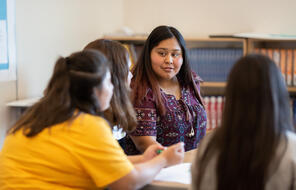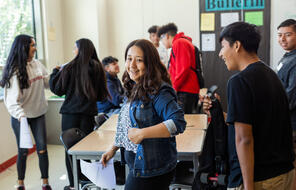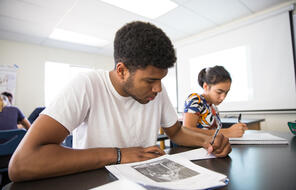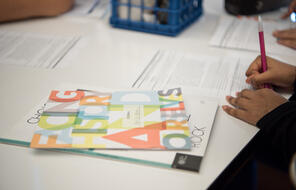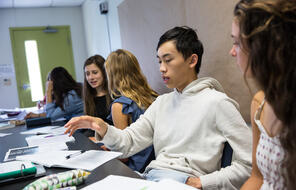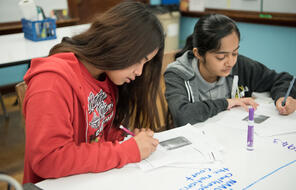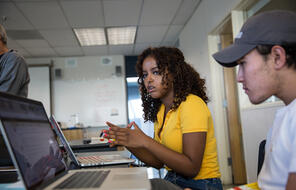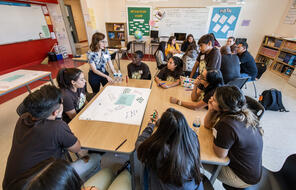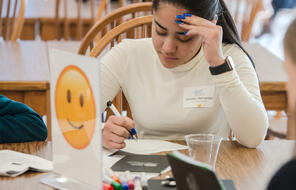Talking About Religion
Subject
- Civics & Citizenship
- History
Language
English — USUpdated
"My struggle to understand the traditions I belong to as mutually enriching rather than mutually exclusive is the story of a generation of young people standing at the crossroads of inheritance and discovery, trying to look both ways at once."
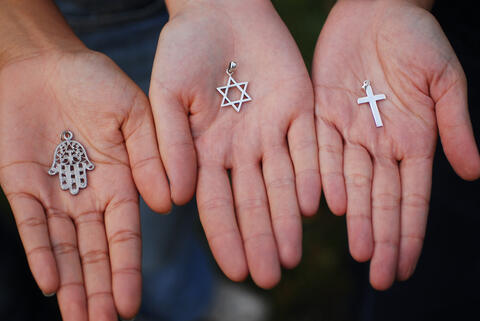
These charms are popular symbols from three Abrahamic religions: Hamsa (Islam), Star of David (Judaism), and Cross (Christianity).
Too often, violence committed by extremists overshadows the stories of young people who are committed to building bridges between people of different religious traditions. Eboo Patel is the founder and executive director of the Interfaith 1 Youth Core. The goal of the program is to create a community of young people who are working to foster understanding between people of different religious backgrounds. In his memoir, Acts of Faith, Patel describes the roots of his own activism:
I am an American Muslim from India. My adolescence was a series of rejections, one after another, of the various dimensions of my heritage, in the belief that America, India, and Islam could not coexist within the same being. If I wanted to be one, I could not be the others. My struggle to understand the traditions I belong to as mutually enriching rather than mutually exclusive is the story of a generation of young people standing at the crossroads of inheritance and discovery, trying to look both ways at once. There is a strong connection between finding a sense of inner coherence and developing a commitment to pluralism 2 . And that has everything to do with who meets you at the crossroads.
When I was in college, I had the sudden realization that all of my heroes were people of deep faith: Dorothy Day, the Dalai Lama, Martin Luther King Jr., Mahatma Gandhi, Malcolm X, the Aga Khan. Moreover, they were all of different faiths. A little more research revealed two additional insights. First, religious cooperation had been central to the work of most of these faith heroes. The Reverend Martin Luther King Jr. partnered with Rabbi Abraham Joshua Heschel in the struggle for civil rights. Mahatma Gandhi stated that Hindu Muslim unity was just as important to him as a free India. Second, each of my faith heroes assumed an important leadership role at a young age. King was only twenty-six years old when he led the Montgomery bus boycott. Gandhi was even younger when he started his movement against unjust laws in early-twentieth-century South Africa.
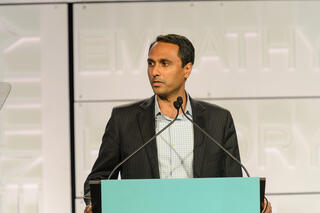
Eboo Patel
. . . In high school, the group I ate lunch with included a Cuban Jew, a Nigerian Evangelical, and an Indian Hindu. We were all devout to a degree, but we almost never talked about our religions with one another. Often somebody would announce at the table that he couldn’t eat a certain kind of food, or any food at all, for a period of time. We all knew religion hovered behind this, but nobody ever offered any explanation deeper than “my mom said,” and nobody ever asked for one.
This silent pact relieved all of us. We were not equipped with a language that allowed us to explain our faith to others or to ask about anyone else’s. Back then, I thought little about the dangers lurking within this absence.
A few years after we graduated, my Jewish friend reminded me of a dark time during our adolescence. There were a group of kids in our high school who, for several weeks, took up scrawling anti-Semitic slurs on classroom desks and making obscene statements about Jews in the hallways. I did not confront them. I did not comfort my Jewish friend. I knew little about what Judaism meant to him, less about the emotional effects of anti-Semitism, and next to nothing about how to stop religious bigotry. So I averted my eyes and avoided my friend, because I couldn’t stand to face him.
A few years later, he described to me the fear he had experienced coming to school those days, and his utter loneliness as he had watched his close friends simply stand by. Hearing him recount his suffering and my complicity is the single most humiliating experience of my life. I did not know it in high school, but my silence was betrayal: betrayal of Islam, which calls upon Muslims to be courageous and compassionate in the face of injustice; betrayal of America, a nation that relies on its citizens to hold up the bridges of pluralism when others try to destroy them; betrayal of India, a country that has too often seen blood flow in its cities and villages when extremists target minorities and others fail to protect them.
My friend needed more than my silent presence at the lunch table. Pluralism is not a default position, an autopilot mode. Pluralism is an intentional commitment that is imprinted through action. It requires deliberate engagement with difference, outspoken loyalty to others, and proactive protection in the breach. You have to choose to step off the faith line onto the side of pluralism, and then you have to make your voice heard. To follow Robert Frost, it is easy to see the death of pluralism in the fire of a suicide bombing. But the ice of silence will kill it just as well. 1
Connection Questions
- How did Patel overcome “rejection”? Who inspired him? What different traditions do they represent? What do they have in common? Who inspires you?
- Patel believes that there is a connection between “inner coherence”—comfort with one’s identity—and a commitment to pluralism—the peaceful coexistence of different groups. What does he mean? How can people balance their own identities and beliefs with a commitment to pluralism?
- Religion is an important part of Patel’s identity. Does religion play a role in the way you see yourself and others?
- Reflecting on his silence, Patel explains that his friends were not equipped to discuss their faith with other people or to ask questions about the differences between their traditions. How can young people become prepared to talk about these issues? What does Patel mean when he talks about the “dangers lurking within this absence”?
- Patel says that he and his friends were bystanders while Jews were intimidated at school. Have you ever been a bystander? Describe the situation. Why didn’t you get involved? How do you and your friends respond when people of different groups feel intimidated by racism and prejudice? How would you like to respond?
- Who is responsible for responding to racist or antisemitic incidents at school? The teachers? The students? The parents?
- 1Reprinted from Acts of Faith: The Story of an American Muslim, the Struggle for the Soul of a Generation, by permission of Beacon Press
How to Cite This Reading
Facing History & Ourselves, “Talking About Religion”, last updated April 10, 2017.


